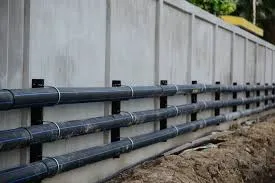Oct . 18, 2024 09:57 Back to list
Understanding Sizes of PVC Irrigation Pipes for Efficient Water Management
Understanding PVC Irrigation Pipe Sizes
Irrigation systems are essential for efficient agricultural practices, ensuring crops receive an adequate water supply. Among the various components of an irrigation system, the choice of pipe material and size is crucial. PVC (polyvinyl chloride) pipes have become a popular choice for irrigation due to their durability, cost-effectiveness, and ease of installation. This article explores PVC irrigation pipe sizes, their dimensions, and how to choose the right size for your needs.
The Importance of Pipe Size
Choosing the correct pipe size is vital for ensuring optimal water flow and pressure throughout the irrigation system. If the pipes are too small, it can lead to inadequate water supply, resulting in poor crop performance. Conversely, oversized pipes can be unnecessarily costly and may require excessive water pressure to function effectively. Therefore, understanding the sizing of PVC irrigation pipes is essential for making informed decisions.
Standard Sizes of PVC Pipes
PVC pipes come in various sizes, typically measured in inches. The most common sizes for irrigation purposes include ½ inch, ¾ inch, 1 inch, 1 ½ inch, 2 inch, and even larger diameters for substantial irrigation systems. The selection of pipe size often depends on factors such as the type of crops being irrigated, the flow rate required, and the layout of the irrigation system.
1. ½ inch to 1 inch These smaller sizes are frequently used for drip irrigation systems. They are suitable for gardens, flower beds, and small agricultural plots where precise water delivery is essential. The smaller diameter pipes allow for controlled water flow, minimizing wastage and ensuring that plants receive the necessary moisture directly to their roots.
2. 1 ½ inch to 2 inch Intermediate sizes are often used in conjunction with larger systems, such as sprinklers or more extensive irrigation setups. These sizes provide a balance between sufficient water flow and pressure, making them ideal for medium-sized farms or larger gardens. Proper sizing at this level helps to maintain consistent water distribution across a broader area.
3. Larger Sizes (3 inch and above) For extensive agricultural operations requiring significant water volume, pipes that are 3 inches or larger are used. These pipes are typically utilized in main supply lines feeding multiple irrigation zones and are crucial for large-scale agricultural practices. Sizing these pipes properly is critical to prevent pressure loss and ensure efficient water delivery to all sections of the farming area.
pvc irrigation pipe sizes

Factors Influencing Pipe Size Selection
When considering which PVC pipe size to use for an irrigation system, several factors come into play
- Flow Rate The amount of water required for the crops plays a significant role in determining the appropriate pipe diameter. Larger flow rates generally necessitate larger pipe sizes to maintain adequate pressure and avoid overflow.
- Irrigation Method Different methods (e.g., drip, sprinkler, surface) may require varying pipe sizes. Drip systems typically necessitate smaller pipes, while sprinkler systems may need larger diameters for effective water distribution.
- Length of Run The distance water needs to travel affects how pressure diminishes over distance. Longer runs may require larger pipes to compensate for pressure loss, ensuring consistent water supply.
- Local Regulations Some regions have regulations concerning irrigation systems and the materials used. It is essential to consult local guidelines before installation to ensure compliance.
Conclusion
Selecting the right PVC irrigation pipe size is fundamental to the efficiency and effectiveness of any irrigation system. By understanding the various sizes available and considering the specific needs of your agricultural practices, you can ensure optimal water flow, improve crop yields, and minimize waste. It is always advisable to consult with irrigation professionals who can provide guidance tailored to your unique situation. With the right pipe size, you can create a sustainable and productive irrigation system that meets your agricultural needs.
-
High-Quality UPVC Electrical Pipe for Safe Wiring Solutions
NewsJul.30,2025
-
Premium PVC Pipe Fitting Supplier – Durable & Leak-Proof Solutions
NewsJul.30,2025
-
High-Gloss PVC Rigid Sheet for Durable & Smooth Surfaces | Wholesale Supply
NewsJul.29,2025
-
High Quality PVC Soft Sheet for Flexible and Durable Applications
NewsJul.29,2025
-
High-Quality PPR Pipe for Plumbing Systems - Durable & Leak-Proof
NewsJul.29,2025
-
High Quality PVC Round Rod for Industrial & DIY Applications
NewsJul.28,2025

